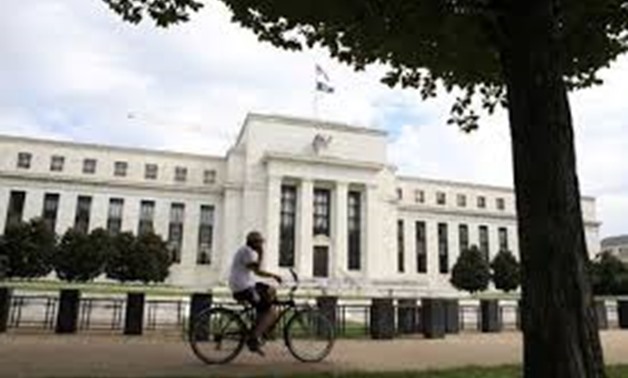
FILE PHOTO: A cyclist passes the Federal Reserve building in Washington, DC, U.S., August 22, 2018. REUTERS/Chris Wattie/File Photo/File Photo
(Reuters) - The Federal Reserve’s plans to continue raising interest rates next year were met with more skepticism on Wall Street on Monday, with futures traders betting on a pause and one major bank partially walking back a hawkish prediction.
The U.S. central bank is still seen raising rates a notch next week in a nod to a hot labor market and economy running well above potential even as inflation remains at target. Yet two volatile months in financial markets and signs of an overseas slowdown have raised doubts the Fed can carry through with the three rate hikes its officials have predicted for 2019.
The sharp tightening of financial conditions convinced Goldman Sachs’ chief economist that the U.S. central bank is now more likely to pause its rate hikes in March, before continuing with three more hikes later in 2019. Goldman had previously predicted four rate hikes next year, far more than that implied by financial markets.
“We think the probability of a move in March has now fallen to slightly below 50 percent,” Goldman’s Jan Hatzius wrote in a note on Monday. But “we see a return to quarterly hikes in June that last through the end of 2019.”
Traders of short-term U.S. interest-rate futures are, for their part, betting the Fed may halt its rate hikes altogether next year, and could even move to cut borrowing costs.
Contracts tied to the Fed’s target rate rose on Monday, reflecting rising worries about U.S. growth prospects amid a global slowdown and doubts about a smooth exit for Britain’s exit from the European Union after Prime Minster Theresa May abruptly postponed a parliamentary vote on her Brexit deal.
Also adding to worries are signs that inflation expectations are slipping, and that the U.S.-China trade dispute has hit rougher waters. All this has weighed on the U.S. stock market as the S&P Index .SPX hit an 8-month low early Monday.
Wall Street ends choppy day higher
The situation on Wall Street, wrote University of Oregon economics professor Tim Duy, is “unpleasant, and it in turn is creating considerable uncertainty about the outlook for monetary policy in 2019.”
Based on prices of Fed fund futures, traders now see a 73 percent chance of a rate hike next week, and just a 49 percent chance of a further rate hike by the end of next year. Contracts expiring in June 2020 are now fetching a higher price than contracts expiring a year earlier, meaning traders are beginning to put some money on a rate cut.
The changing predictions put a spotlight on the Fed’s own expectations, which it will update next Wednesday when it delivers its expected fourth rate hike of the year.

Comments
Leave a Comment